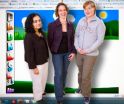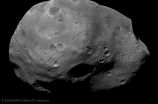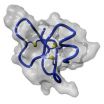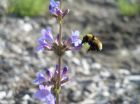(Press-News.org) BUFFALO, N.Y. -- An innovative, educational computing platform developed by University at Buffalo faculty members and hosted by the cloud (remote, high-capacity, scalable servers) is helping UB students understand parts of evolutionary biology on an entirely new level. Soon, high-school and middle-school students will benefit from the same tool as well.
Pop! World, developed by UB faculty members with a $250,000 National Science Foundation grant, takes advantage of cloud computing, which allows programs to run on remote servers instead of through departmental or institutional servers. That feature allows resource-intensive programs to serve many users regardless of their physical location without sacrificing speed or quality of service.
"The cloud serves as a way to distribute resources for free without limits on how many people can access it and with no regard to what kind of computer you are downloading to," says Jessica Poulin, PhD, research assistant professor in the Department of Biological Sciences in the College of Arts and Sciences, who developed Pop! World with principal investigator Bina Ramamurthy, PhD, research associate professor in the Department of Computer Science and Engineering in the School of Engineering and Applied Sciences, and Katharina Dittmar, PhD, assistant professor of biological sciences. "Everybody can get there."
UB faculty members designed Pop! World because they wanted to get college students more excited about population genetics; they also wanted to maintain the university's unique freshman lab requirements at a time when resources are growing more scarce.
UB is one of the few universities in the U.S. that encourages freshmen interested in biology to begin experiencing labs during their first semester on campus.
"We put our freshmen right into labs because students who might otherwise be lost from the major are captivated when they get to do science," Poulin says. "When you sit in a lecture hall with 400 people and someone is talking about flatworms, what do you care? Despite the logistical difficulties, and the intense demands on staff time, we think that getting freshmen into labs is one of our department's great strengths. We didn't want to discontinue it."
At the same time, Poulin says that it is difficult to convey the main concepts of population genetics at this level, particularly those that are mathematically demanding.
Hired in 2008 to revamp UB's evolutionary biology curriculum for Bio 200, Poulin says that the department was seeking ways to maintain and improve the course and the lab for students without requiring additional resources, such as teaching assistants.
"Almost all of evolutionary theory can be mathematically modeled if you know enough information to begin with," she says. "If you enter the correct parameters into the computer, the computer will tell you what will happen after one generation or a thousand generations. I wanted students to be exposed to something that made them feel they were actually watching evolution happen. I wanted it to be captivating."
While some computational tools exist to help students with population genetics -- the mathematical analysis of evolution -- the result is often nothing more dramatic than a line graph.
"Our students grew up in the Internet age surrounded by MP3 players, wireless phones and social networking apps," says Ramamurthy, "so the visual aspects of Pop! World are certainly very appealing to them."
The UB team programmed Pop! World in Adobe Flash, which lends a highly visual, nearly tactile look to the program. While the current version illustrates evolution with red and green lizards, it is highly adaptable, so it can be used with any population of organisms. It also is highly scalable, so that it can be made more complex, to serve the needs of population genetics researchers, or less complex, to serve the needs of middle- and high-school students.
A preliminary version of Pop! World is running on the Google App Engine Cloud. It can be accessed by going to http://popworld15.appspot.com/.
With the help of the NSF grant, the UB team is now creating a sophisticated version of the tool, expected to be available by Fall 2011.
"Our idea was to use general principles of population genetics not only to convey the principle in the context of evolutionary biology but to make sure that students understand visually what's happening with the mathematics behind it," explains Dittmar.
When an early version of Pop! World was used to teach evolutionary biology last summer, students and teaching assistants responded enthusiastically.
"The TAs loved it because it facilitated their explanations of a very complicated problem," Poulin says.
"Pop! World gives students the visual background they need to understand complex mathematical problems," Dittmar adds. "And it works kind of like a video game, which serves the current population of undergrads well."
That visual appeal is also expected to go far with middle-school and high-school biology students, groups the UB team hopes to excite about evolution; by spring, they expect to have completed a modified version for them as well.
By making evolutionary biology more visually appealing and, thus, more accessible, Poulin hopes that Pop! World will make evolution itself a more appealing subject for secondary schools to teach.
"There's a huge disconnect," she says. "The universities all accept evolution as fact. It's not a question. But many high schools and middle schools don't want to touch it. They don't want to deal with the politics of it."
Her hope is that the visual and educational appeal of Pop! World and the ease of using it will begin to change that situation.
The UB team's grant, "A Cloud-enabled Evolutionary Genetics Learning Tool for Engaging the Cyber-savvy Generation" (NSF OCI CI-Team 1041280) from the NSF's Office of Cyberinfrastructure, will run for two years.
INFORMATION:
Hongsik Kim, Jungeun Lee and Byunghun Jang, all former UB graduate students in the Department of Computer Science and Engineering, also were involved in the project.
The University at Buffalo is a premier research-intensive public university, a flagship institution in the State University of New York system and its largest and most comprehensive campus. UB's more than 28,000 students pursue their academic interests through more than 300 undergraduate, graduate and professional degree programs. Founded in 1846, the University at Buffalo is a member of the Association of American Universities.
With cloud computing, the mathematics of evolution may get easier to learn
Software developed by UB faculty conserves resources in a unique freshman bio lab
2011-01-22
ELSE PRESS RELEASES FROM THIS DATE:
New melt record for Greenland ice sheet
2011-01-22
New research shows that 2010 set new records for the melting of the Greenland Ice Sheet, expected to be a major contributor to projected sea level rises in coming decades.
"This past melt season was exceptional, with melting in some areas stretching up to 50 days longer than average," said Dr. Marco Tedesco, director of the Cryospheric Processes Laboratory at The City College of New York (CCNY – CUNY), who is leading a project studying variables that affect ice sheet melting.
"Melting in 2010 started exceptionally early at the end of April and ended quite late in mid- ...
Preventing tooth decay in the youngest American Indians
2011-01-22
INDIANAPOLIS – A study conducted in four American Indian communities in the Pacific Northwest presents an effective strategy to convince mothers to switch young children from drinking sweetened soda to water and shows that eliminating these sugary drinks from the diets of the youngest members of the tribe significantly decreased tooth decay.
The results of the dental arm of "The Toddler Overweight and Tooth Decay Prevention Study" (TOTS), which targeted American Indians from birth to 30 months of age, appear in the current issue (Volume 20, Number 4) of the peer reviewed ...
Mars Express close flybys of martian moon Phobos
2011-01-22
Mars Express has returned images from the Phobos flyby of 9 January 2011. Mars Express passed Mars' largest moon at a distance of 100km.
The HRSC-camera recorded images of Phobos on 9 January 2011 at a distance of 100 km with a
resolution of 8.1 m/pixel. Due to the stereo viewing geometry during the flyby a small part of
the moon’s edge is only visible for the right eye resulting in odd 3D-perception in this area.
This part has been slightly adjusted for better viewing. Also, for the left eye at the left
edge of the image four small data gaps have ...
Defense mechanism against bacteria and fungi deciphered
2011-01-22
Under standard laboratory conditions, the human beta-defensin 1 (hBD-1), a human antibiotic naturally produced in the body, had always shown only little activity against microbes. Nevertheless the human body produces it in remarkable quantities. The solution to the puzzle was the investigation process itself, as the research group led by Dr. Jan Wehkamp at the Dr. Margarete Fischer-Bosch Institute for Clinical Pharmacology of the Stuttgart-based Robert Bosch Hospital found out.
Before the research group took a new approach to this research, defensins were usually tested ...
NFL linemen recover from back surgery, and so can you
2011-01-22
CHICAGO --- If NFL linemen can recover from back surgery and return to their spine-bruising careers, so can you get back into your "game" of horsing around with your kids or working out at the gym after back surgery.
That's the good news from a new Northwestern Medicine study that found 80 percent of NFL lineman – whose spines are especially vulnerable to degeneration – were able to return to play many more games after the surgery. These elite athletes spend a lot of time in a squatting stance that puts tremendous stress on their spine.
The study is encouraging ...
Mindfulness meditation training changes brain structure in 8 weeks
2011-01-22
Participating in an 8-week mindfulness meditation program appears to make measurable changes in brain regions associated with memory, sense of self, empathy and stress. In a study that will appear in the January 30 issue of Psychiatry Research: Neuroimaging, a team led by Massachusetts General Hospital (MGH) researchers report the results of their study, the first to document meditation-produced changes over time in the brain's grey matter.
"Although the practice of meditation is associated with a sense of peacefulness and physical relaxation, practitioners have long ...
Islands in the sky: How isolated are mountain top plant populations?
2011-01-22
Do mountain tops act as sky islands for species that live at high elevations? Are plant populations on these mountain tops isolated from one another because the valleys between them act as barriers, or can pollinators act as bridges allowing genes to flow among distant populations?
Dr. Andrea Kramer and colleagues from the Chicago Botanic Garden and the University of Illinois at Chicago were interested in pursuing these questions, particularly for a genus of plants, Penstemon (Plantaginaceae), endemic to the Great Basin region of the Western United States. They published ...
Researchers discover how to tame hammering droplets
2011-01-22
CAMBRIDGE, Mass. -- A water hammer can occur when a valve is suddenly opened or closed in a pipe carrying water or steam, causing a pressure wave to travel down the pipe with enough force that it can sometimes cause the pipes to burst. Now, new research shows that a similar effect takes places on a tiny scale whenever a droplet of water strikes a surface.
MIT's Kripa Varanasi, co-author of a report on the new finding published this week in the journal Physical Review Letters, says the phenomenon could help engineers design more durable condensing surfaces, which are used ...
Study of nutrition, Alzheimer's links hampered by research approach
2011-01-22
CORVALLIS, Ore. – Research is trying to determine whether Alzheimer's disease might be slowed or prevented with nutritional approaches, but a new study suggests those efforts could be improved by use of nutrient "biomarkers" to objectively assess the nutrient status of elderly people at risk for dementia.
The traditional approach, which primarily relies on self-reported dietary surveys, asks people to remember what they have eaten. Such surveys don't consider two common problems in elderly populations – the effect that memory impairment has on recall of their diet, or ...
Aquatic food web tied to land
2011-01-22
Millbrook, NY – A distant relative of shrimp, zooplankton are an important food source for fish and other aquatic animals. Long characterized as algae feeders, a new study published this week in the Proceedings of the National Academy of Sciences reports that nearly a third of zooplankton diets are supported by material that originates on land in lake watersheds.
The study brings scientists one step closer to clarifying the role that watershed inputs play in aquatic food webs. While it has been recognized that animals living at the bottom of lakes and streams rely, in ...
LAST 30 PRESS RELEASES:
Keck Medicine of USC names Christian Pass chief financial officer
Inflatable fabric robotic arm picks apples
MD Anderson and SOPHiA GENETICS announce strategic collaboration to accelerate AI-driven precision oncology
Oil residues can travel over 5,000 miles on ocean debris, study finds
Korea University researchers discover that cholesterol-lowering drug can overcome chemotherapy resistance in triple-negative breast cancer
Ushikuvirus: A newly discovered giant virus may offer clues to the origin of life
Boosting the cell’s own cleanup
Movement matters: Light activity led to better survival in diabetes, heart, kidney disease
Method developed to identify best treatment combinations for glioblastoma based on unique cellular targets
Self-guided behavioral app helps children with epilepsy sleep earlier
Higher consumption of food preservatives is associated with an increased risk of type 2 diabetes
NTU Singapore-led team captures first-ever ‘twitch’ of the eye’s night-vision cells as they detect light, paving the way for earlier detection of blindness-causing diseases
Global aviation emissions could be halved through maximising efficiency gains, new study shows
Fewer layovers, better-connected airports, more firm growth
Exposure to natural light improves metabolic health
As we age, immune cells protect the spinal cord
New expert guidance urges caution before surgery for patients with treatment-resistant constipation
Solar hydrogen can now be produced efficiently without the scarce metal platinum
Sleeping in on weekends may help boost teens’ mental health
Study: Teens use cellphones for an hour a day at school
After more than two years of war, Palestinian children are hungry, denied education and “like the living dead”
The untold story of life with Prader-Willi syndrome - according to the siblings who live it
How the parasite that ‘gave up sex’ found more hosts – and why its victory won’t last
When is it time to jump? The boiling frog problem of AI use in physics education
Twitter data reveals partisan divide in understanding why pollen season's getting worse
AI is quick but risky for updating old software
Revolutionizing biosecurity: new multi-omics framework to transform invasive species management
From ancient herb to modern medicine: new review unveils the multi-targeted healing potential of Borago officinalis
Building a global scientific community: Biological Diversity Journal announces dual recruitment of Editorial Board and Youth Editorial Board members
Microbes that break down antibiotics help protect ecosystems under drug pollution
[Press-News.org] With cloud computing, the mathematics of evolution may get easier to learnSoftware developed by UB faculty conserves resources in a unique freshman bio lab





